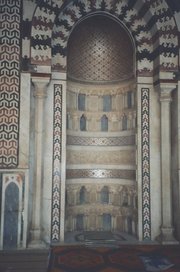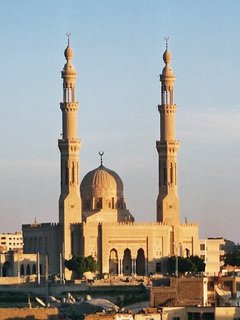Mosque
|
|
A mosque is a place of worship for followers of the Islamic faith. Masǧid or Masjid (pl. masajid) (Arabic: مسجد - pronounced: // or //) is the Arabic term for a mosque. This term is used widely throughout the Islamic world, and the word masjid is widely preferred by many Muslims. The word masjid is from the arabic root sajad which means to prostrate; Islamic prayers require prostration.
The first masjid in the world was the Kaaba in Mecca. The first masjid in Medina, a city north of Mecca, was the house of the Prophet Muhammad, to which the followers of Muhammad had withdrawn in 622. The reconstructions of Muhammad's house show a large courtyard containing a relatively small house. After many worshippers complained about the heat of the midday sun, Muhammad had a row of palm trunks erected on one side of the courtyard and a roof of palm fronds laid between the columns and the outer wall, creating a shaded prayer space. He himself stood at one end of this simple arcade to preach.
Typical parts of a mosque and their functions
Muslims are commanded to offer Salah (Prayer) five times a day: morning (Fajr), midday (Dhuhr), afternoon (Asr), sunset (Maghrib), and evening (Isha)- see Five Pillars of Islam for details. A muezzin calls the worshippers to prayer from the minaret (Arabic manara). Many mosques do not admit non-Muslims into the buildings.
Because Islamic prayer must be preceded by ritual purification, mosques have ablution fountains or other facilities for washing in their entryways or courtyards. In many mosques this function is elaborated into a freestanding building in the center of a courtyard.

Entry into the mosque from the ablution area - courtyard or vestibule - leads to an open room without furniture. The architecture of this prayer hall is typically undifferentiated - often a forest of columns or a grid filled with adjacent domes covers the space. The visually emphasized area is usually the wall opposite the entry, the Qibla wall. The qibla wall should, in a properly oriented mosque, be set perpendicular to a line leading to Mecca (Arabic, "Makkah"). The faithful kneel in rows parallel to the qibla wall and thus have arranged themselves to face Mecca. In the qibla wall, usually in its center, is the Mihrab, a niche or depression indicating that this is the qibla wall. The mihrab is not occupied by any furniture, unlike the apse often found around the altar of Christian churches. If there is a raised minbar, or pulpit for Friday sermons, it is to the side of the mihrab.
Many forms of mosque have evolved in different regions of the Islamic world. Notable mosque-types include the early Abbasid mosques, T-type mosques, and the central-dome mosques of Anatolia. The oil-wealth of the 20th century drove a great deal of mosque construction using designs from leading non-Muslim modern architects and promoting the careers of important contemporary Muslim architects. The Aga Khan Award for Architecture, offered since 1977, rewards both architects working in manners rooted in Islamic tradition and those working in international styles.
See also
External links
- The Sultan Ahmet Mosque(Blue mosque), Istanbul (Masjid) (http://perso.wanadoo.fr/istanbul/mosqueebleue.htm)
- A gallery of pictures of Masjids from around the world, from Asia through to America (http://haqaonline.lightuponlight.com/pg/index.php?cat=5)
- Directory of Muslim Businesses and Mosques in the United Kingdom (http://www.tijarapages.com/)
- Ma'sajid Around the World (islamicfinder.org) (http://www.islamicfinder.org/gallery/index.php?cat=10)
- The Mosque Review (Masjid) (http://www.islamicarchitecture.org/architecture/themosque.htm)os:Мæзджыт
ar:مسجد bg:Джамия da:Moske de:Moschee et:Mošee es:Mezquita eo:Moskeo fa:مسجد fr:Mosquée id:Masjid he:מסגד nl:Moskee ja:モスク pl:Meczet pt:Mesquita (templo islâmico) simple:Mosque sl:MoÅ¡eja fi:Moskeija sv:Moské zh:清真寺

